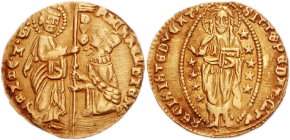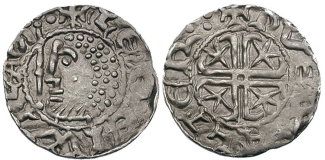Economic Expansion
Explain how Europe benefited from cultural diffusion during the period c. A.D. 1000 - 1500.

Venetian Gold Ducat c. 1400
The trade accompanying the Crusades decisively shifted the financial axis from Constantinople to Western Europe. This long - distance trade monetized the markets, transformed banking practices, and stimulated the growth of towns and cities across Europe.
Trade was fed by major silver strikes across Western Europe in the 12th century, and the outpouring of specie allowed for the minting of silver currencies based on the denier, or penny.
In 1231, Frederick II, the Holy Roman Emperor, introduced the first standard gold coin issued in Western Europe since the 7th century, known as the augustalis. Venetians and Florentines followed suit with their ducat and florin, destined to become the coins of international trade well into the 16th century.

English Short Cross Penny
Without any significant mines of their own, the kings of England struck their pennies from silver imported in payment for English textiles. English short-cross pennies at 92.5 percent fine were prized as trade coins in the Rhineland (Western Germany).
The French kings based a new royal silver currency on the denier tournois. In Germany, the pfennig (the German equivalent of the penny) of Cologne was preferred.
The revived prosperity of Islam in the 13th century depended on European silver and specie brought into Near Eastern markets by the Venetians and Genoese. The Ottoman Empire, for all of its political and military success, was always tied to the European currencies and depended on imported specie from European markets.
The changes in the Mediterranean economy had profound repercussions across Europe in other fields of activity. The increase in commerce and coined money made monetized markets common to Europeans. Prosperity increased the number of iron tools available and spread the use of the coulter plough and horse collar and the three-field system was widely adopted. Hence, agricultural productivity rose, particularly in Central and Eastern Europe.
A greater efficiency in farming, lessened the potential of famine. As less farmers were needed to feed an increasing population, people began migrating to towns and cities. This in turn led to greater economic specialization, one that was increasing based on money instead of barter.
Monastic manors were also commercialized. Relationships between lords and serfs changed as lords increasingly preferred payment of rents in cash rather than in - kind or labor services.
Lords, preferring cash crops, developed demesne farming of their own estates by planting specialized crops destined for markets.
These would later be known as cash - crops
, because the goal is no longer self - sufficiency, but rather the ability to aquire currency which in turn could be used to
purchase necessities and prestige goods of the nobility.

